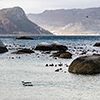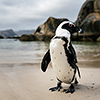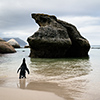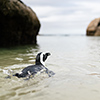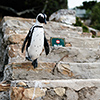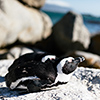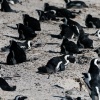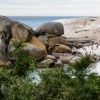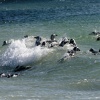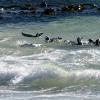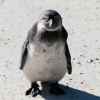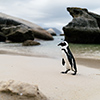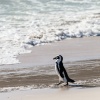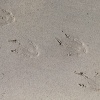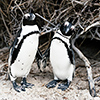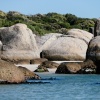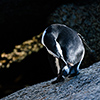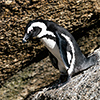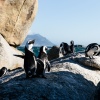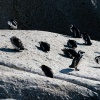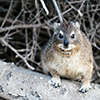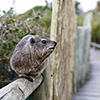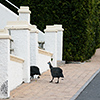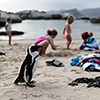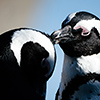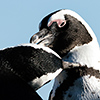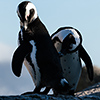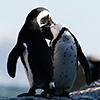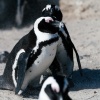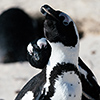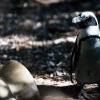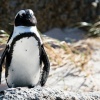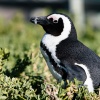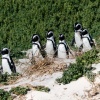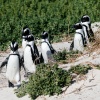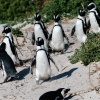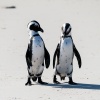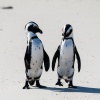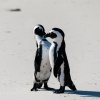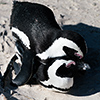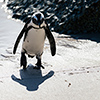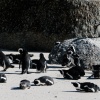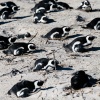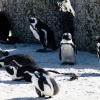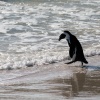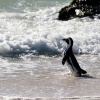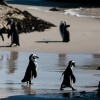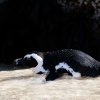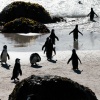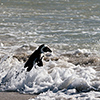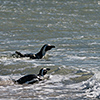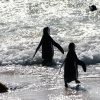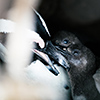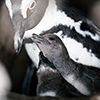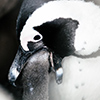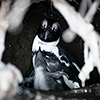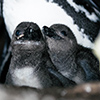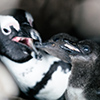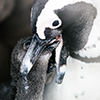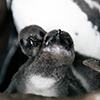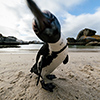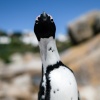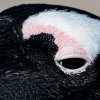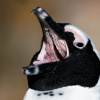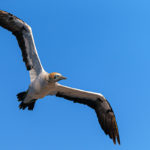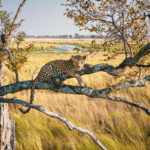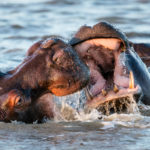Very well dressed – The African penguins of Simon’s Town
Penguins are rather linked to ice and Antarctica than to heat and Africa. In the south of Cape Town is a fishermen village called Simon’s Town that is home to one of the most famous and accessible colonies worldwide: the jackass penguins of picturesque Boulders Beach.
Life on the Beach
It is incredibly windy, back then, on a Wednesday morning in January 2015 as well as now, a Saturday afternoon in February 2017. The elements whip sand over the ground and even generally calm Ocean spumes a lot more than usual. Strong winds even tie Table Mountain Cable Car to the ground for a few days now, but in the south of Cape Town is a place where life takes no break, as well-dressed little folks get ready for fishing in the sea.
Fortunately the Simon’s Town-based colony of jackass penguins is stable again and wherever one looks are knee-high guys in tailcoats spending big time on catching the first sunlight of a new day as well as indulging themselves in mutual plumage grooming. Cuddled up they brave strong wind and the whipping sand or just escape from that natural peeling by climbing one of those roundish rocks being Boulders Beach name giver.
In small groups the birds waddle from the thicket down to the beach and feel their way into the cold water. Having barely reached the sea their clumsy walk turns into elegant swimming. Here, at the Boulders Beach, humans have a chance to enjoy a swim with penguins in the chilly water of False Bay.
Bathing with them is like when planets are orbiting, as the animals decide how close one can come. They circle around you, come closer and dive away again. An unforgettable experience, that I repeat as often as I can since 2003, when I visited Cape Town for the time first time.
Back in 2003 there was no fence and Simon’s Town residents often had penguins in their houses. Today the colony is more protected, from cats and dogs, but also from a too severe visitors’ influence as their majority only pops in the visitor centre and only few people make it down to the beach. In general the little guys are as cool as Fonzie when it comes to contact with humans. Only some of the birds are really shy and most penguins accept tourists within a sphere of privacy measuring only few centimetres.
If one gets too close – each bird defines that barrier individually, like we humans do – then they start snapping, what definitely would leave an aching memory behind as their sharp hooked bill is studded with countless little barb teeth inside. The shear force of a penguin bill is tremendous. It is their guarantee of being a successful fish hunter, meaning food for themselves as well as their chicks.
The Boulders Beach jackass penguins are not the only penguins in Africa as other settlements can be found along the entire southwestern and western coast, even up in Namibia. Those spots are so old that yet rock paintings and engravings of nomads and natives tell about them.
The Simon’s Town colony is much younger. First penguins were seen over here back in 1982. Since then its population grew up to 3.000 animals, what is basically attributable to commercial fishing for pilchards and anchovies in False Bay having taken a backseat. The Boulders Bay colony isn’t the largest of its kind but definitely the most accessible community of tailcoat wearing little guys. They will make not only children’s eyes shine very bright.
Their worst enemy is the human
South African summer easily lets Cape Town thermometers climb up to 35°C and in Namibia, at the coast of Richtersveld, temperatures even reach 50°C. That doesn’t sound like proper living conditions for animals preferring rather cold, very cold latitudes. Hence the birds’ activity is most busy at early morning and late afternoon, but during the day they mostly hide away in the shadow.
The cold water of Benguela Current that’s starting in Antarctica is very rich in nutrients. The whole maritime food chain profits from it over here, at the southern end of Africa. And that’s why the penguins took up permanent residence along southwestern and western coast of the continent, as it is home to tremendous schools of pilchards and anchovies.
The largest penguins become about 70cm tall weighting up to 3.5kg. The chicks on the other hand barely fit the cup being formed by two human hands. They immediately start calling and begging for food already when an adult only walks past the nest. Natural breeding burrows, earth holes become rare, hence a little human help is necessary. If the plastic burrows are all occupied then the birds breed on the very beach. Of course visitors aren’t permitted at that part of the coast as well as in the heart of the colony.
From such a natural breeding burrow emerges a continuous cheeping and squeaking. Mother just came back home and their few days old chicks know intuitively that dinner’s ready. Alive and kicking they start billing and cooing to express their hunger. Mother doesn’t hesitate long, opens her throat and regurgitates to feed the chicks with finest pre-digested anchovies ;-)
When they don’t stand around like garden gnomes to brave the strong winds then mutual plumage grooming is central activity. Their plucking, tidying and straightening of feathers shows how tight and close a penguin relationship is. Also when in the water and being on the fish hunt they socialise and communicate like an old Berlin pub before the Wall fell down.
In the water dozens of little black tails are up in the air as they bath and cackle, but when it comes to breeding places then they show no mercy. Each penguin walking past gets quacked at, if not even pinched only because someone’s thinking to pay the much higher rent. For the much more likeable penguins that is a survival instrument, but when New Berliners behave like that, then it’s nothing but sad, chavvy and egoistic contempt for mankind.
Further down at the beach two penguins suddenly start dancing around each other. Never losing their partner out of sight, their little ballet disembogues in an amorous tête-à-tête right on the beach. New life gets created while hard wind whips sand gusts into our faces. Another penguin waddles up and down the entire beach searching for something. Proud like a Spaniard it’s returning to its nest with an old branch.
Against the background of many chicks and juveniles the bird population seems to do well and the colony appeared being stable during my visits in 2015 and 2017. Appearances are deceiving though, as humans always were, are and will ever be their worst enemy. Scarcely anybody one of the selfie taking idiots flocking to Boulders Beach knows that the count of little tailcoat guys dropped dramatically from ~1.5 million to some 60.000 birds within only 100 years. That’s a loss of more than 90%. Between 1900 and 1930 just from Dassen Island some 13 million penguin eggs got stolen to end up in a pan; to cook scrambled eggs…
Also the mining of Guano – that’s the droppings of those fish eaters – meant a significant negative turning point in the life of penguins; in particular on St. Croix Island off the coast of P.E. Additionally they struggled with pollution and being oiled up or algae producing bio toxins. Since 2000 the population of South African penguin colonies has dropped by 60%. From the bottom of my heart I am wishing that those little enchanting guys won’t disappear.

